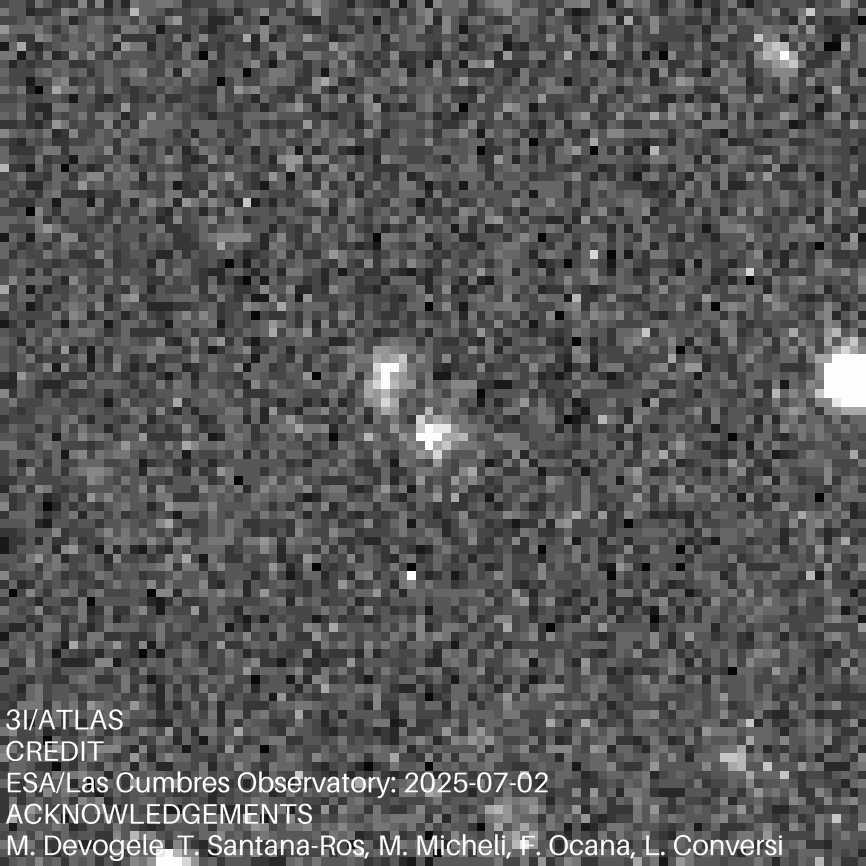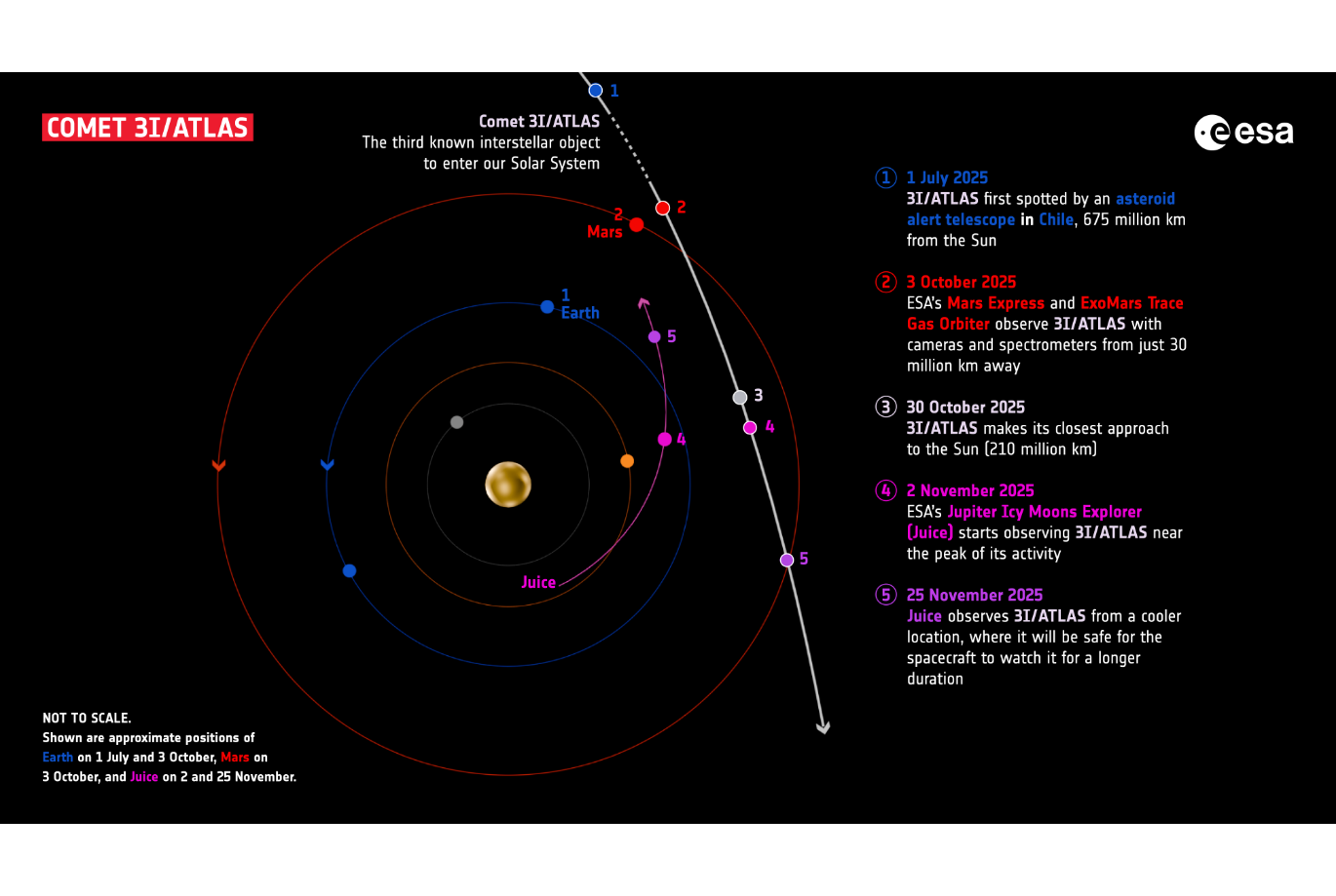The European Space Agency (ESA) has used images taken by the ExoMars Trace Gas Orbiter while interstellar comet 3I/ATLAS was hidden from earthly observers by the Sun to refine calculations of the comet’s orbit. The work not only improves our understanding of the visitor, but could improve predictions of objects on a potential collision course with Earth.
Even with many of the world’s largest telescopes focused on it, astronomers struggled to calculate 3I/ATLAS’s position and movements precisely after it was discovered on July 1. It’s simply not that easy to measure something so small and moving so fast at such a great distance.
To make things worse, the path was not perfectly predictable. When gases stream off comets they can cause deviations in their orbits, like a rocket firing its thrusters, and if one side loses more gas than the other things can literally go sideways.
By the time 3I/ATLAS was close enough to the Sun for gas release to increase, the Earth was on the wrong side and the Sun was blocking our view. These days, however, there are spacecraft visiting other planets and asteroids, or on their way. They don’t have the resolution of Hubble or the JWST, but some were much better positioned.
ExoMars TGO is one of those, and its operators at the European Space Agency (ESA) took time off its primary mission to search for 3I/ATLAS between October 1 and 7. “This was a very challenging observation for the instrument. The comet is around 10,000 to 100,000 times fainter than our usual target,” ESA’s Nick Thomas said at the time. However, with the comet passing at 29 million kilometers (17 million miles or an eighth of Mars’ average distance from the Sun) the mission was up to the task.
With shorter exposure time, Mars Express couldn’t manage the same.

It’s not the sharpest image, but considering that 3I/ATLAS is thousands of times more distant than EXOMars TGO’s usual targets, it’s amazing it is visible at all.
Image credit: ESA/Las Cumbres Observatory
The combination of being closer and observing from a different angle allowed the ESA team to triangulate data from ExoMars TGO and Earth to find 3I/ATLAS’s path much more precisely, which in turn improved predictions of where it would go. Instead of the small improvement they anticipated, the ESA astronomers reduced the uncertainty in the comet’s trajectory by a factor of 10.
One benefit of this greater precision is that once the comet emerged from behind the Sun for earthly telescopes, less searching was required to find it.
More importantly, by knowing the comet’s path without adjustments created by subsequent gas release, the work created a baseline to measure the effect of future outbursts.
If the deviations are in line with normally cometary behavior, it might lay to rest the claims by Professor Avi Loeb of Harvard University that 3I/ATLAS might be an alien spacecraft, despite other astronomers’ skepticism. Don’t expect Loeb to admit defeat just yet, however.
Using ExoMars TGO’s data in this way wasn’t easy. We’ve had centuries of calculating comets’ orbits based on earthly observations, and sometimes from near-Earth orbit. Redoing those calculations for measurements taken from Mars would be a novelty, but not too challenging. However, ExoMars TGO is in orbit around Mars, its location constantly changing compared to the Red Planet, let alone to everything else. Several ESA teams had to combine their skills to process the data effectively.

3I/ATLAS’s path through the Solar System, the planets and the missions it will pass.
Image credit: ESA
An even bigger challenge is underway with the Jupiter Icy Moon’s Explorer (JUICE) on its way to Jupiter, currently the closest human-made object to 3I/ATLAS. It has been observing the comet since November 2, and will continue until November 25, offering yet another perspective to refine the orbit. Unfortunately, JUICE can’t use its main antenna as a heat shield and send back data with it at the same time. Since JUICE is still close enough to the Sun to need shielding, data is trickling back via the smaller antenna, so its observations won’t be available until February, after 3I/ATLAS is far on its way out.
Besides testing improbable claims, the work has another purpose: it provides an opportunity to refine our techniques for calculating the orbits of future objects that may pose a threat to Earth. If we spot an asteroid that might hit Earth, or might make a very narrow miss, knowing how to best use a spacecraft that happens to be in its vicinity as it approaches, could be very useful.
As the number of space missions increases and their targets diversify, the chances of one being suitably positioned rise. ESA doesn’t want to rely on chance however. They’re planning the NEOMIR mission, which will look to cover the primary blind spot of asteroids approaching Earth from near the Sun, giving us three weeks’ notice of significant threats.
Source Link: Data From Mars Lets ESA Predict 3I/ATLAS’s Path 10 Times More Precisely